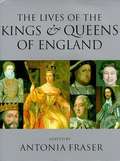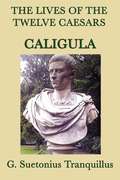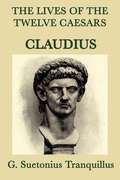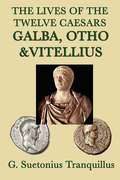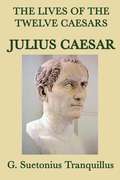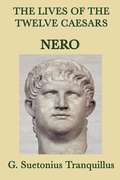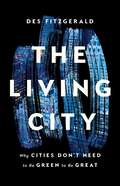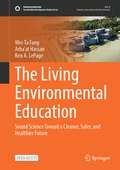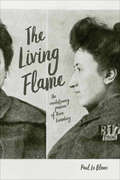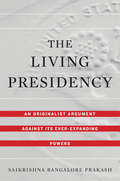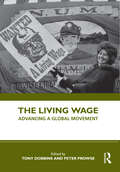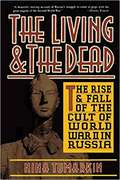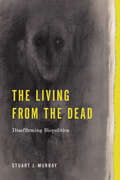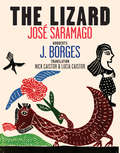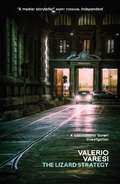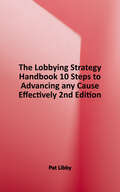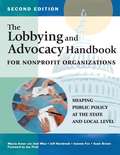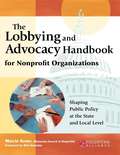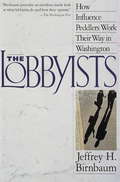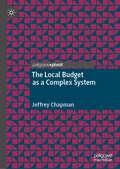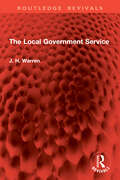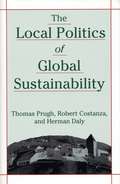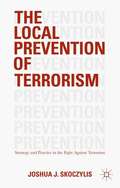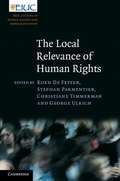- Table View
- List View
The Lives of the Kings and Queens of England
by Antonia FraserUpdated with a new chapter on the Windsors, including the death of Diana, this reference offers a concise guide to the great dynasties of English royalty.
The Lives of the Twelve Caesars: Caligula
by G. Suetonias TranquillisThe Twelve Caesars, is a set of twelve biographies of Julius Caesar and the first 11 emperors of the Roman Empire written by Gaius Suetonius Tranquillus. The work, written in AD 121 during the reign of the emperor Hadrian, was the most popular work of Suetonius, at that time Hadrian's personal secretary, and is the largest among his surviving writings. The Twelve Caesars is considered very significant in antiquity and remains a primary source on Roman history.
The Lives of the Twelve Caesars: Claudius
by G. Suetonias TranquillisThe Twelve Caesars, is a set of twelve biographies of Julius Caesar and the first 11 emperors of the Roman Empire written by Gaius Suetonius Tranquillus. The work, written in AD 121 during the reign of the emperor Hadrian, was the most popular work of Suetonius, at that time Hadrian's personal secretary, and is the largest among his surviving writings. The Twelve Caesars is considered very significant in antiquity and remains a primary source on Roman history.
The Lives of the Twelve Caesars: Galba, Otho, Vitellius
by G. Suetonius TranquillusThe Twelve Caesars, is a set of twelve biographies of Julius Caesar and the first 11 emperors of the Roman Empire written by Gaius Suetonius Tranquillus. The work, written in AD 121 during the reign of the emperor Hadrian, was the most popular work of Suetonius, at that time Hadrian's personal secretary, and is the largest among his surviving writings. The Twelve Caesars is considered very significant in antiquity and remains a primary source on Roman history.
The Lives of the Twelve Caesars: Julius Caesar
by G. Suetonias TranquillisThe Twelve Caesars, is a set of twelve biographies of Julius Caesar and the first 11 emperors of the Roman Empire written by Gaius Suetonius Tranquillus. The work, written in AD 121 during the reign of the emperor Hadrian, was the most popular work of Suetonius, at that time Hadrian's personal secretary, and is the largest among his surviving writings. The Twelve Caesars is considered very significant in antiquity and remains a primary source on Roman history.
The Lives of the Twelve Caesars: Nero
by G. Suetonias TranquillisThe Twelve Caesars, is a set of twelve biographies of Julius Caesar and the first 11 emperors of the Roman Empire written by Gaius Suetonius Tranquillus. The work, written in AD 121 during the reign of the emperor Hadrian, was the most popular work of Suetonius, at that time Hadrian's personal secretary, and is the largest among his surviving writings. The Twelve Caesars is considered very significant in antiquity and remains a primary source on Roman history.
The Living City: Why Cities Don't Need to Be Green to Be Great
by Des FitzgeraldA sociologist explores why &“green cities&” won&’t fix everything—and urges us to celebrate urban life as it is Everywhere you look, cities are getting greener. The general assumption is clear: if something is unhealthy or bad about urban life today, then nature holds the cure. However, argues sociologist Des Fitzgerald, green spaces are not the panacea that people think. In The Living City, Fitzgerald tours the international green city movement that has flourished across the world and discovers the deep, sometimes troubling, roots of our desire to connect cities to nature. Talking to policy makers, planners, scientists, and architects, Fitzgerald suggests that underneath the wish to turn future cities green is another wish: to make the modern city, and perhaps the modern world, disappear altogether. Ultimately, he makes an argument for celebrating the contemporary city as it is—in all its noisy, constructed, artificial glory.
The Living Environment: Principles, Connections, And Solutions (12th edition)
by G. Tyler MillerThis textbook is an introduction to environmental science. It is an interdisciplinary science that uses concepts and information from natural sciences such as ecology, biology, chemistry, and geology and social sciences such as economics, politics, and ethics to (1) help us understand how the earth works, (2) learn how we are affecting the earth's life-support systems (environment) for us and other forms of life, and (3) propose and evaluate solutions to the environmental problems we face.
The Living Environmental Education: Sound Science Toward a Cleaner, Safer, and Healthier Future (Sustainable Development Goals Series)
by Wei-Ta Fang Ben A. LePage Arba'at HassanThis open access book is designed and written to bridge the gap on the critical issues identified in environmental education programs in Asian countries. The world and its environments are changing rapidly, and the public may have difficulty keeping up and understanding how these changes will affect our way of life. The authors discuss various topics and case studies from an Asian perspective, but the content, messaging, and lessons learned need not be limited to Asian cultures. Each chapter provides a summary of the intensive research that has been performed on pro-environmental behaviors, the experience of people working in industry and at home, and their philosophies that guide them in their daily lives. We highlight humanity’s potential to contribute to Sustainable Development Goals (SDGs) by understanding better the environmental psychology, social inclusion, and environmental sustainability and stewardship protection elements that contribute to responsible environmental citizenship. The content of the chapters in this book includes a discussion of the crucial issues, plans, and evaluations for sustainability theories, practices, and actions with a proposed management structure for maximizing the cultural, social, and ecological diversity of Asian experiences compared to other theories and cultures internationally. We intend that the data in this book will provide a comprehensive guide for students, professors, practitioners, and entrepreneurs of environmental education and its related disciplines using case studies that demonstrate the relationship between the social and behavioral sciences and environmental leadership and sustainability.
The Living Flame: The Revolutionary Passion of Rosa Luxemburg
by Paul Le BlancA collection of essays illuminating the historic Polish philosopher, economist, and activist&’s tremendous contributions to revolutionary struggle. Rosa Luxemburg, brilliant early twentieth century German revolutionary, comes alive in a rich set of essays on her life, ideas, and lasting influence. The essays deal not only with her remarkable contributions to political, social and economic theory, but also touch on her vibrant personality and intimate friendships. This collection, the fruit of more than four decades of involvement with Luxemburg's work, simultaneously showcases her penetratingly intellectual, political and deeply humanistic qualities.&“An indispensable contribution to our understanding of Rosa Luxemburg, who emerges as formidable theorist, principled activist, and above all, a fully realized human being . . . . The Living Flame affirms Luxemburg&’s lasting contribution and underscores the relevance of her legacy for our own, very different, age.&” —Helen Scott, author, The Storm of History: Shakespeare&’s Tempest and Capitalism &“A profound and multidimensional investigation of a giant thinker and revolutionary. These [essays] show meticulous historical and theoretical attentiveness and at the same time are hugely timely; a significant contribution to Rosa Luxemburg studies and Marxist theory and history.&” —Dana Mills, author, Rosa Luxemburg: Critical Lives &“Uncommonly nuanced, probing, and also deeply principled explorations. [Le Blanc&’s] mode of engagement nicely compliments that of Rosa Luxemburg and shows us her thoughts as a living and breathing work in progress, not merely echoes from an increasingly distant past. In addition, Le Blanc models how Marxists and Leftists in general might want to relate to one another when we debate complex issues and at times disagree.&” —Axel Fair-Schulz, associate professor at SUNY Potsdam
The Living Presidency: An Originalist Argument against Its Ever-Expanding Powers
by Saikrishna Bangalore PrakashA constitutional originalist sounds the alarm over the presidency’s ever-expanding powers, ascribing them unexpectedly to the liberal embrace of a living Constitution. Liberal scholars and politicians routinely denounce the imperial presidency—a self-aggrandizing executive that has progressively sidelined Congress. Yet the same people invariably extol the virtues of a living Constitution, whose meaning adapts with the times. Saikrishna Bangalore Prakash argues that these stances are fundamentally incompatible. A constitution prone to informal amendment systematically favors the executive and ensures that there are no enduring constraints on executive power. In this careful study, Prakash contends that an originalist interpretation of the Constitution can rein in the “living presidency” legitimated by the living Constitution. No one who reads the Constitution would conclude that presidents may declare war, legislate by fiat, and make treaties without the Senate. Yet presidents do all these things. They get away with it, Prakash argues, because Congress, the courts, and the public routinely excuse these violations. With the passage of time, these transgressions are treated as informal constitutional amendments. The result is an executive increasingly liberated from the Constitution. The solution is originalism. Though often associated with conservative goals, originalism in Prakash’s argument should appeal to Republicans and Democrats alike, as almost all Americans decry the presidency’s stunning expansion. The Living Presidency proposes a baker’s dozen of reforms, all of which could be enacted if only Congress asserted its lawful authority.
The Living Wage: Advancing a Global Movement
by Tony DobbinsAs wealth inequality skyrockets and trade union power declines, the living wage movement has become ever more urgent for public policymakers, academics, and – most importantly – those workers whose wages hover close to the breadline. A real living wage in any part of the world is rarely its minimum wage: it is the minimum income needed to cover living costs and participate fully in society. Most governments’ minimum wages are still falling short, meaning millions of workers struggle to cover their living costs. This book brings new, vital insights to the conversation from a carefully selected group of contributors at the forefront of this field. By juxtaposing advances across sectors and countries, and encompassing many different approaches and indeed definitions of the living wage, Dobbins and Prowse offer a rich tapestry of approaches that may inform public policy. By including the experiences and voices of those workers earning at, or near, the living wage alongside the opinions of leading experts in this field, this book is a pioneering contribution for public policymakers as well as students and academics of work and employment relations, public policy, organizational studies, social economics, and politics.
The Living and the Dead: The Rise and Fall of the Cult of World War II in Russia
by Nina TumarkinThis eye-opening book shows how Communist state and party authorities stage-managed the Soviets' memory of World War II, transforming a national trauma into a heroic exploit that glorified the party while systematically concealing the disastrous mistakes and criminal cruelties committed by the Stalinist tyranny.
The Living from the Dead: Disaffirming Biopolitics (RSA Series in Transdisciplinary Rhetoric)
by Stuart J. MurrayIn a society that aims above all to safeguard life, how might we reckon with ethical responsibility when we are complicit in sacrificial economies that produce and tolerate death as a necessity of life?Arguing that biopower can be fully exposed only through an analysis of those whom society has “let die,” Stuart J. Murray employs a series of transdisciplinary case studies to uncover the structural and rhetorical conditions through which biopower works. These case studies include the concept of “sacrifice” in the “war” against COVID-19, where emergent cultures of pandemic “resistance” are explored alongside suicide bombings and military suicides; the California mass hunger strikes of 2013; legal cases involving “preventable” and “untimely” childhood deaths, exposing the irreconcilable claims of anti-vaxxers and Indigenous peoples; and the videorecording of the death of a disabled Black man. Murray demonstrates that active resistance to biopower inevitably reproduces tropes of “making live” and “letting die.” His counter to this fact is a critical stance of disaffirmation, one in which death disrupts the politics of life itself.A philosophically nuanced critique of biopower, The Living from the Dead is a meditation on life, death, power, language, and control in the twenty-first century. It will appeal to students and scholars of rhetoric, philosophy, and critical theory.
The Lizard
by Jose SaramagoA story by Nobel Prize-winning writer Jose Saramago, gorgeously illustrated in woodcuts by one of Brazil's most famous artists.When a lizard appears in the neighborhood of Chiado, in Lisbon, it surprises passers-by, and mobilizes firefighters and the army. With a clear and precise style, the fable offers a multitude of senses, reaching audiences of all ages. "The Lizard" is a short story included in A Bagagem do Viajante (1973), a volume that brought together the Saramago chronicles for the newspaper A Capital and the weekly Jornal do Fundão between 1971 and 1972. Translated by Nick Caistor and Lucia Caistor, The Lizard, is an illustrated version of the chronicle by J. Borges.
The Lizard Strategy
by Valerio VaresiItaly's Maigret returns in another smouldering noir from a master of the police procedural "A master storyteller" Barry Forshaw, IndependentParma is blanketed in snow, but this pristine, white veneer cannot mask the stench of corruption. Its officials are no longer working for its people - only for themselves - crime is out of control and resentment festers in every district. Commissario Soneri remains at heart an idealist, so the state of Parma wounds him more than most. And now he is presented with three mysteries at once, each more impenetrable than the last. In a river creek on the outskirts of the city, tipped off by a local, he finds a mobile phone that rings through the night but holds no data; an elderly patient with senile dementia is reported missing from a hospice; and the mayor of Parma, who was reported as taking a holiday on the ski slopes, has disappeared off the face of the earth - just when he seemed certain to be implicated in a seismic corruption scandal at city hall.
The Lobbying Strategy Handbook: 10 Steps to Advancing Any Cause Effectively
by Pat LibbyThis handbook demonstrates how those who are passionate about a cause can successfully advocate at the state and local levels. Pat Libby's 10-step strategic model walks the reader through the essential elements of conducting a lobbying campaign from start to finish. This framework is illustrated by four case studies - and accompanying campaign materials - that show how groups of real students successfully used the 10-step model to pass significant laws. The 10-step model is bracketed by an explanation of how to effectively use technology in lobbying campaigns, and guidance about what to do once a bill has passed. Undergraduate, graduate students, and anyone interested in making a difference, can use the book to guide them in creating and conducting a grassroots campaign from start to finish.
The Lobbying and Advocacy Handbook for Nonprofit Organizations (Second Edition)
by Marcia Avner Josh Wise Jeff Narabrook Jeannie Fox Susie Brown Jon PrattThe Lobbying and Advocacy Handbook for Nonprofit Organizations, Second Edition, is your complete road map to shaping public policy at the state and local level. It gives detailed, step-by-step instructions for developing an effective plan and putting it into action. With this handbook, you will discover how lobbying can help fulfill your mission; learn how to initiate, support, or defeat bills; develop effective lobbying skills; gather and mobilize support for your positions; learn how to use the media effectively; influence gov't administrators to back your policy positions; comply with state and federal regulations; and set up systems in your nonprofit to support lobbying. In addition to updated worksheets, case studies, and resources, new material in the second edition includes nonprofit civic engagement and voter mobilization; designing the Policy Committee that works for your nonprofit; utilizing social media in your communications strategies; administrative advocacy: working with governmental agencies; and understanding the why, what and how of collaboration.
The Lobbying and Advocacy Handbook for Nonprofit Organizations: Shaping Public Policy at the State and Local Level
by Marcia AvnerThe author provides broad scope of information and road map for nonprofit lobbying at the state and local level.
The Lobbyists
by Jeffrey BirnbaumJeffrey H. Birnbaum's The Lobbyists exposes the world of Washington's most influential players -- the more than eighty thousand who descend upon our national government, informing and bartering with Congress and blocking legislation on behalf of the richest business interests in the country. This acclaimed work -- now with a new introduction that analyzes the changes in lobbying in 1990s -- provides a shocking view of how our government really works.
The Local Budget as a Complex System (Palgrave Studies in Public Debt, Spending, and Revenue)
by Jeffrey ChapmanThis book examines budgeting by analyzing the local government budget as a complex system, thus adding a new dimension to traditional budget textbooks. It is designed to complement existing texts—not replace—by putting the budget in a complex system, general equilibrium framework. A complex systems framework adds to conventional budget analysis in at least four ways: It looks at the budget as the result of many variables that are outside the finance department’s purview; it understands that there are multiple interdependences among these variables; it suggests analysis of non-obvious relationships among actions in the budget process in order to optimize results; and it argues that the actors in the process must understand that their budgetary behaviors have indirect and far-reaching implications that go beyond the budget document. This book also uses concepts seldom discussed in the budgetary literature—that of governance, including concepts of the facilitative state, with adjustments for exogenous shocks; the forms of decision making; and the political climate of the jurisdiction. This framework notes methods of success of firms in the private sector that operate in environments of rapid technological change. While becoming a popular theoretical framework for how private sector firms change, dynamic capability analysis has received little attention in the public management field. This book utilizes DC since public sector organizations also face rapidly changing environments. Lastly, the book discusses the potential relationship between the local budget and local community welfare maximization.
The Local Government Service (Routledge Revivals)
by J. H. WarrenFirst Published in 1952, The Local Government Service describes in general terms the character and extent of the tasks which the body of public servants employed by the local authorities is called upon to perform. Part I comprises a general survey; Part II studies in greater detail the character and work of the agencies which are shaping the service - the organizations of employers and staff, the Whitley machinery, and the local authority in its capacity as an individual employer; while Part III deals with the more important aspects and issues of qualification and training in a way which could not have been attempted in part I without impeding the narrative.This is a must read for students of public administration and political science.
The Local Politics of Global Sustainability
by Robert Costanza Herman E. Daly Thomas PrughThe most difficult questions of sustainability are not about technology; they are about values. Answers to such questions cannot be found by asking the "experts," but can only be resolved in the political arena. In The Local Politics of Global Sustainability, author Thomas Prugh, with Robert Costanza and Herman Daly, two ofthe leading thinkers in the field of ecological economics, explore the kind of politics that can help enable us to achieve a sustainable world of our choice, rather than one imposed by external forces.The authors begin by considering the biophysical and economic dimensions of the environmental crisis, and tracing the crisis in political discourse and our public lives to its roots. They then offer an in-depth examination of the elements of a re-energized political system that could lead to the development of more sustainable communities. Based on a type of self-governance that political scientist Benjamin Barber calls "strong democracy," the politics is one of engagement rather than consignment, empowering citizens by directly involving them in community decisionmaking. After describing how it should work, the authors provide examples of communities that are experimenting with various features of strong democratic systems.The Local Politics of Global Sustainability explains in engaging, accessible prose the crucial biophysical, economic, and social issues involved with achieving sustainability. It offers a readable exploration of the political implications of ecological economics and will be an essential work for anyone involved in that field, as well as for students and scholars in environmental politics and policy, and anyone concerned with the theory and practical applications of the concept of sustainable development.
The Local Prevention of Terrorism: Strategy And Practice In The Fight Against Terrorism
by Joshua SkoczylisThis book explores the success and failures of the Prevent strategy, which was developed by the UK Government to help stop people becoming terrorists or supporting terrorism. It provides a holistic overview of the policy's formation, delivery and impact on Muslim communities.
The Local Relevance of Human Rights
by George Ulrich Koen De Feyter Stephan Parmentier Christiane TimmermanDo human rights offer real protection when disadvantaged groups invoke them at the local level in an attempt to improve their living conditions? If so, how can we make sure that the experiences of those invoking human rights at the local level have an impact on the further development of human rights (at national and other levels) so that the local relevance of human rights increases? Since the adoption of the Universal Declaration of Human Rights (UDHR) on 10 December 1948, numerous international documents have reaffirmed human rights as global norms. This book examines what factors determine whether appeals to human rights that emanate from the local level are successful, and whether the UDHR adequately responds to threats as currently defined by relevant groups or whether a revision of some of the ideas included in the UDHR is needed in order to increase its contemporary relevance.
